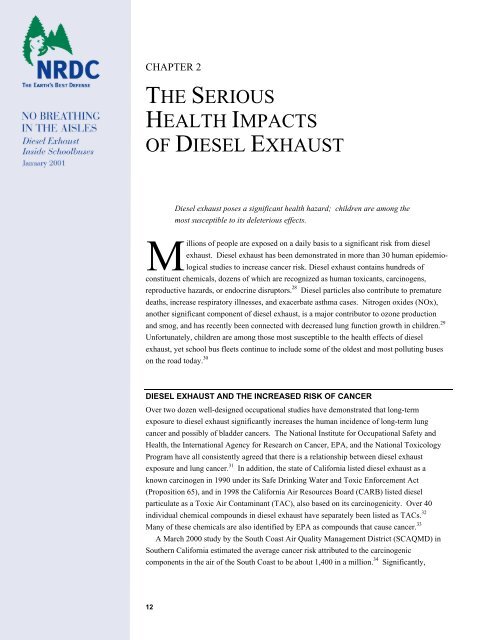NRDC: No Breathing in the Aisles: Diesel Exhaust Inside School ...
NRDC: No Breathing in the Aisles: Diesel Exhaust Inside School ...
NRDC: No Breathing in the Aisles: Diesel Exhaust Inside School ...
Create successful ePaper yourself
Turn your PDF publications into a flip-book with our unique Google optimized e-Paper software.
CHAPTER 2<br />
THE SERIOUS<br />
HEALTH IMPACTS<br />
OF DIESEL EXHAUST<br />
12<br />
<strong>Diesel</strong> exhaust poses a significant health hazard; children are among <strong>the</strong><br />
most susceptible to its deleterious effects.<br />
illions of people are exposed on a daily basis to a significant risk from diesel<br />
exhaust. <strong>Diesel</strong> exhaust has been demonstrated <strong>in</strong> more than 30 human epidemiological<br />
studies to <strong>in</strong>crease cancer risk. <strong>Diesel</strong> exhaust conta<strong>in</strong>s hundreds of<br />
constituent chemicals, dozens of which are recognized as human toxicants, carc<strong>in</strong>ogens,<br />
reproductive hazards, or endocr<strong>in</strong>e disruptors. 28 <strong>Diesel</strong> particles also contribute to premature<br />
deaths, <strong>in</strong>crease respiratory illnesses, and exacerbate asthma cases. Nitrogen oxides (NOx),<br />
ano<strong>the</strong>r significant component of diesel exhaust, is a major contributor to ozone production<br />
and smog, and has recently been connected with decreased lung function growth <strong>in</strong> children. 29<br />
Unfortunately, children are among those most susceptible to <strong>the</strong> health effects of diesel<br />
exhaust, yet school bus fleets cont<strong>in</strong>ue to <strong>in</strong>clude some of <strong>the</strong> oldest and most pollut<strong>in</strong>g buses<br />
on <strong>the</strong> road today. 30<br />
M<br />
DIESEL EXHAUST AND THE INCREASED RISK OF CANCER<br />
Over two dozen well-designed occupational studies have demonstrated that long-term<br />
exposure to diesel exhaust significantly <strong>in</strong>creases <strong>the</strong> human <strong>in</strong>cidence of long-term lung<br />
cancer and possibly of bladder cancers. The National Institute for Occupational Safety and<br />
Health, <strong>the</strong> International Agency for Research on Cancer, EPA, and <strong>the</strong> National Toxicology<br />
Program have all consistently agreed that <strong>the</strong>re is a relationship between diesel exhaust<br />
exposure and lung cancer. 31 In addition, <strong>the</strong> state of California listed diesel exhaust as a<br />
known carc<strong>in</strong>ogen <strong>in</strong> 1990 under its Safe Dr<strong>in</strong>k<strong>in</strong>g Water and Toxic Enforcement Act<br />
(Proposition 65), and <strong>in</strong> 1998 <strong>the</strong> California Air Resources Board (CARB) listed diesel<br />
particulate as a Toxic Air Contam<strong>in</strong>ant (TAC), also based on its carc<strong>in</strong>ogenicity. Over 40<br />
<strong>in</strong>dividual chemical compounds <strong>in</strong> diesel exhaust have separately been listed as TACs. 32<br />
Many of <strong>the</strong>se chemicals are also identified by EPA as compounds that cause cancer. 33<br />
A March 2000 study by <strong>the</strong> South Coast Air Quality Management District (SCAQMD) <strong>in</strong><br />
Sou<strong>the</strong>rn California estimated <strong>the</strong> average cancer risk attributed to <strong>the</strong> carc<strong>in</strong>ogenic<br />
components <strong>in</strong> <strong>the</strong> air of <strong>the</strong> South Coast to be about 1,400 <strong>in</strong> a million. 34 Significantly,
















